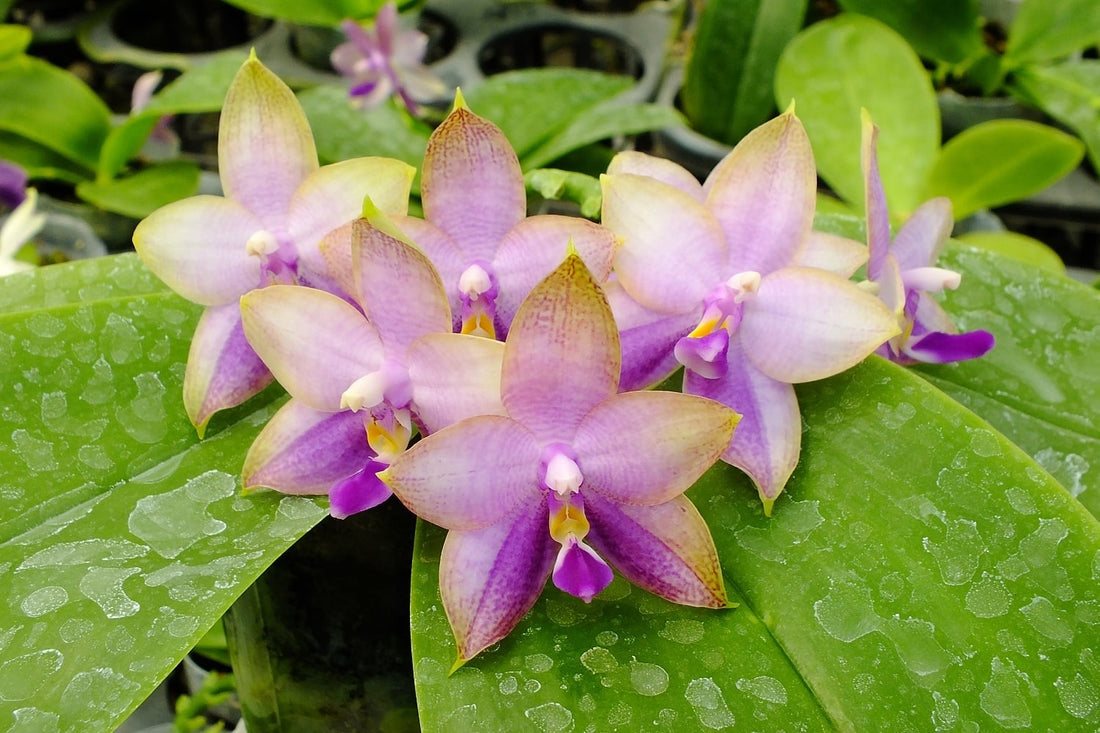Lighting is one of the most critical factors for growing healthy, vigorous novelty Phalaenopsis orchids. Unlike standard supermarket Phalaenopsis, many novelty hybrids originate from warmer, brighter environments, meaning they require more precise light conditions to thrive and rebloom consistently.
At HCorchids.com, we specialize in high-quality novelty Phalaenopsis orchids, and in this guide, we’ll dive deep into how to optimize lighting for maximum growth and flowering.
Why Lighting Matters for Novelty Phalaenopsis
Light is the primary driver of photosynthesis, the process that fuels orchid growth, flower production, and overall health. For novelty Phalaenopsis, proper lighting determines:
✅ Leaf & Root Development – Strong light promotes thicker, healthier leaves and an extensive root system.
✅ Bloom Frequency & Flower Quality – Insufficient light leads to skipped blooming cycles or weak spikes with fewer flowers.
✅ Growth Rate – Higher light levels (within safe limits) speed up the time between new leaf and spike production.
The challenge? Too little light results in weak growth, while too much causes leaf scorch. Let’s explore how to strike the perfect balance.
Understanding Light Intensity for Novelty Phalaenopsis
1. Measuring Light: Foot-Candles & Lux
Light intensity is measured in foot-candles (fc) or lux (1 fc = ~10.76 lux). Novelty Phalaenopsis typically require:
• 2,000–3,000 foot-candles (fc) (20,000–32,000 lux) for optimal growth.
• Standard supermarket Phalaenopsis thrive at 1,000–1,500 fc, meaning novelty Phals need nearly double the intensity.
How to Measure Light at Home
To ensure your orchids are receiving the right amount of light, you can:
• Use a light meter – Devices like the Dr. Meter LX1330B accurately measure foot-candles and lux.
• Use a smartphone app – Apps like “Photone” (iOS) or “Lux Light Meter” (Android) provide a general estimate.
• Observe leaf color – Dark green leaves indicate low light, while reddish-tinged edges suggest high light exposure.
2. Best Natural Light Conditions for Novelty Phalaenopsis
Ideal Window Placement
The best window location depends on your climate and how much direct sun your space receives:
|
Window Direction |
Light Intensity |
Suitable for Novelty Phals? |
|
South-facing |
High (3,000–4,000 fc) |
Yes, but requires sheer curtains to diffuse direct sunlight. |
|
East-facing |
Moderate (2,000–3,000 fc) |
Ideal—gentle morning light without overheating. |
|
West-facing |
High (3,000–4,000 fc) |
Good, but may need shading in hot climates. |
|
North-facing |
Low (500–1,500 fc) |
Not enough light; supplement with grow lights. |
Seasonal Light Adjustments
• Winter – Days are shorter, and light intensity drops. Move orchids closer to the window or use grow lights.
• Summer – Light levels increase, but heat intensifies. Use sheer curtains to prevent leaf burn.
Pro Tip: If your orchids receive more than 2 hours of direct sun, use a 30–50% shade cloth or sheer curtain to diffuse harsh light.
Artificial Lighting for Novelty Phalaenopsis
If natural light is insufficient, full-spectrum LED grow lights can provide consistent, adjustable lighting conditions.
1. Best Types of Grow Lights for Novelty Phalaenopsis
✅ Full-Spectrum LED (Preferred)
• Mimics natural sunlight, providing balanced red, blue, and white light.
• Energy-efficient and produces minimal heat.
• Recommended: Spider Farmer SF1000, Barrina T5 LED, or Sansi Full-Spectrum Bulbs.
✅ T5 Fluorescent Tubes (Good for Shelving Setups)
• Provide moderate intensity and work well for seedlings and low-light orchids.
• Require frequent bulb replacements (every 6–12 months).
❌ Avoid Red/Blue LED Panels
• While effective for photosynthesis, they distort plant coloration and make it harder to assess leaf health.
2. Light Duration: How Many Hours Do Novelty Phals Need?
The duration of light exposure is just as important as intensity. Novelty Phalaenopsis need:
• 12–14 hours of light per day in spring and summer.
• 14–16 hours in fall and winter to compensate for shorter days.
• 8–10 hours of darkness per night to allow proper respiration.
💡 Tip: Use a smart plug or timer to automate your grow light schedule and maintain consistent light cycles.
Signs of Too Much or Too Little Light
Symptoms of Low Light (Under 1,500 fc)
❌ Dark green, floppy leaves.
❌ No new flower spikes for over a year.
❌ Slow root growth, few aerial roots.
Solution: Move to a brighter location or add a full-spectrum grow light.
Symptoms of Too Much Light (Above 3,500 fc Without Diffusion)
❌ Leaves turn reddish-purple or yellow (indicating stress).
❌ Sunburn spots appear as white or black patches.
❌ Leaf tips become dry and crispy.
Solution: Move orchids further from direct light or use a sheer curtain to filter intensity.
Maximizing Blooms with Light Optimization
To encourage frequent and high-quality blooms, follow these advanced lighting techniques:
1️⃣ Increase light intensity gradually – Moving an orchid from low to high light too quickly can shock it. Transition over 2–3 weeks.
2️⃣ Rotate plants every 1–2 weeks – Ensures all sides receive equal light, preventing lopsided growth.
3️⃣ Encourage spike formation with light cycles – If your Phalaenopsis isn’t spiking, increase light exposure to 14+ hours daily for a few weeks.
4️⃣ Supplement light during winter – Consistent exposure prevents flower spikes from stalling.
5️⃣ Maintain proper humidity – Bright light increases transpiration, so keep 50–70% humidity to prevent dehydration.
Conclusion: Mastering Light for Novelty Phalaenopsis Success
Proper lighting is the foundation of strong growth and repeat blooming for novelty Phalaenopsis. By fine-tuning light intensity, duration, and quality, you can ensure your orchids:
✔ Grow thicker leaves and stronger roots.
✔ Produce consistent, high-quality blooms year-round.
✔ Thrive even in low natural light environments with proper supplementation.
Looking for rare, high-quality novelty Phalaenopsis orchids? 🌸
Visit HCorchids.com to explore our curated selection of fragrant, exotic, and collector-grade Phalaenopsis today!


1 comment
Living in Norway.